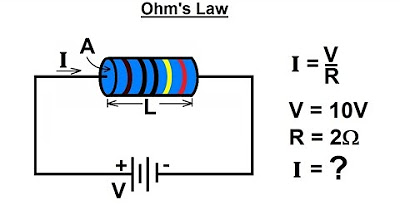Resistivity and conductivity | Circuits | Physics | Khan Academy
Summary
TLDRThis video explains the concept of electrical resistance, starting with Ohm's Law and how resistance is defined by voltage and current. It highlights the factors that influence resistance, such as the resistor's length, cross-sectional area, and material composition, introducing the concept of resistivity. The video also emphasizes the importance of understanding these variables in calculating resistance. Through a water flow analogy, the video makes these concepts more intuitive. Finally, the video demonstrates how to calculate resistance in a practical scenario using a copper wire, showing how small values of resistance can still impact sensitive experiments.
Takeaways
- 😀 Ohm's law states that the voltage across a resistor equals the current through it times the resistance, allowing us to define resistance.
- 😀 The resistance of a resistor is a constant as long as the material, size, and shape remain unchanged, regardless of voltage or current.
- 😀 The resistance of a resistor depends on its length, cross-sectional area, and the material it's made of.
- 😀 Increasing the length of a resistor increases its resistance, while increasing its cross-sectional area decreases resistance.
- 😀 The resistance is directly proportional to the length of the resistor and inversely proportional to its cross-sectional area.
- 😀 The resistivity of a material quantifies its natural resistance to current flow. Higher resistivity means greater resistance.
- 😀 Metals have low resistivity, making them good conductors, while non-metals or insulators have high resistivity.
- 😀 The formula for resistance includes resistivity, length, and area: R = ρ * (L/A).
- 😀 Resistivity has units of ohm meters, which can be remembered using the 'Replay' mnemonic (R = ρ * L / A).
- 😀 Electrical conductivity is the inverse of resistivity. A good conductor has low resistivity, and a poor conductor has high resistivity.
- 😀 An analogy with water flowing through pipes helps visualize resistance: smaller pipe area or longer length increases resistance to water flow, just like in a resistor.
Q & A
What is Ohm's Law and how is it used to define resistance?
-Ohm's Law states that the voltage across a resistor equals the current through it times the resistance. It defines resistance as the ratio of the voltage applied across a resistor to the current flowing through it, with resistance measured in ohms.
Does increasing voltage affect the resistance of an Ohmic material?
-No, increasing the voltage does not change the resistance of an Ohmic material. The resistance remains constant regardless of the voltage or current, as long as the material and its dimensions do not change.
What factors can change the resistance of a resistor?
-The resistance of a resistor can change based on its length, cross-sectional area, and the material it is made of. A longer resistor increases resistance, while a larger cross-sectional area decreases resistance. The material's resistivity also plays a key role.
How does the length of a resistor affect its resistance?
-Resistance is directly proportional to the length of the resistor. Increasing the length of the resistor increases the resistance, as the current has to flow through a longer path.
How does the cross-sectional area of a resistor affect its resistance?
-Resistance is inversely proportional to the cross-sectional area of the resistor. A larger area allows more room for current to flow, reducing the resistance.
What is resistivity, and how does it affect resistance?
-Resistivity is a material property that quantifies how strongly a material resists the flow of current. Materials with high resistivity, like rubber, offer more resistance, while materials with low resistivity, like copper, offer less resistance.
What are the units of resistivity?
-The units of resistivity are ohm-meters (Ω·m), which result from the formula for resistivity that relates resistance, length, and cross-sectional area.
How can the relationship between resistivity, resistance, length, and area be remembered easily?
-A mnemonic to remember the formula for resistivity is 'Replay.' The letters correspond to resistance (R), resistivity (ρ), length (L), and area (A) in the formula R = ρ(L/A).
How does conductivity relate to resistivity?
-Conductivity is the inverse of resistivity. A material with high resistivity is a poor conductor, while a material with high conductivity is a good conductor.
How can the analogy of water flowing through a pipe help understand resistance?
-In the water analogy, the resistance to current flow through a pipe is affected by the length and diameter of the pipe, just as the resistance of a wire depends on its length and cross-sectional area. A constricted pipe, like a smaller area in a wire, increases resistance.
Outlines

This section is available to paid users only. Please upgrade to access this part.
Upgrade NowMindmap

This section is available to paid users only. Please upgrade to access this part.
Upgrade NowKeywords

This section is available to paid users only. Please upgrade to access this part.
Upgrade NowHighlights

This section is available to paid users only. Please upgrade to access this part.
Upgrade NowTranscripts

This section is available to paid users only. Please upgrade to access this part.
Upgrade Now5.0 / 5 (0 votes)





